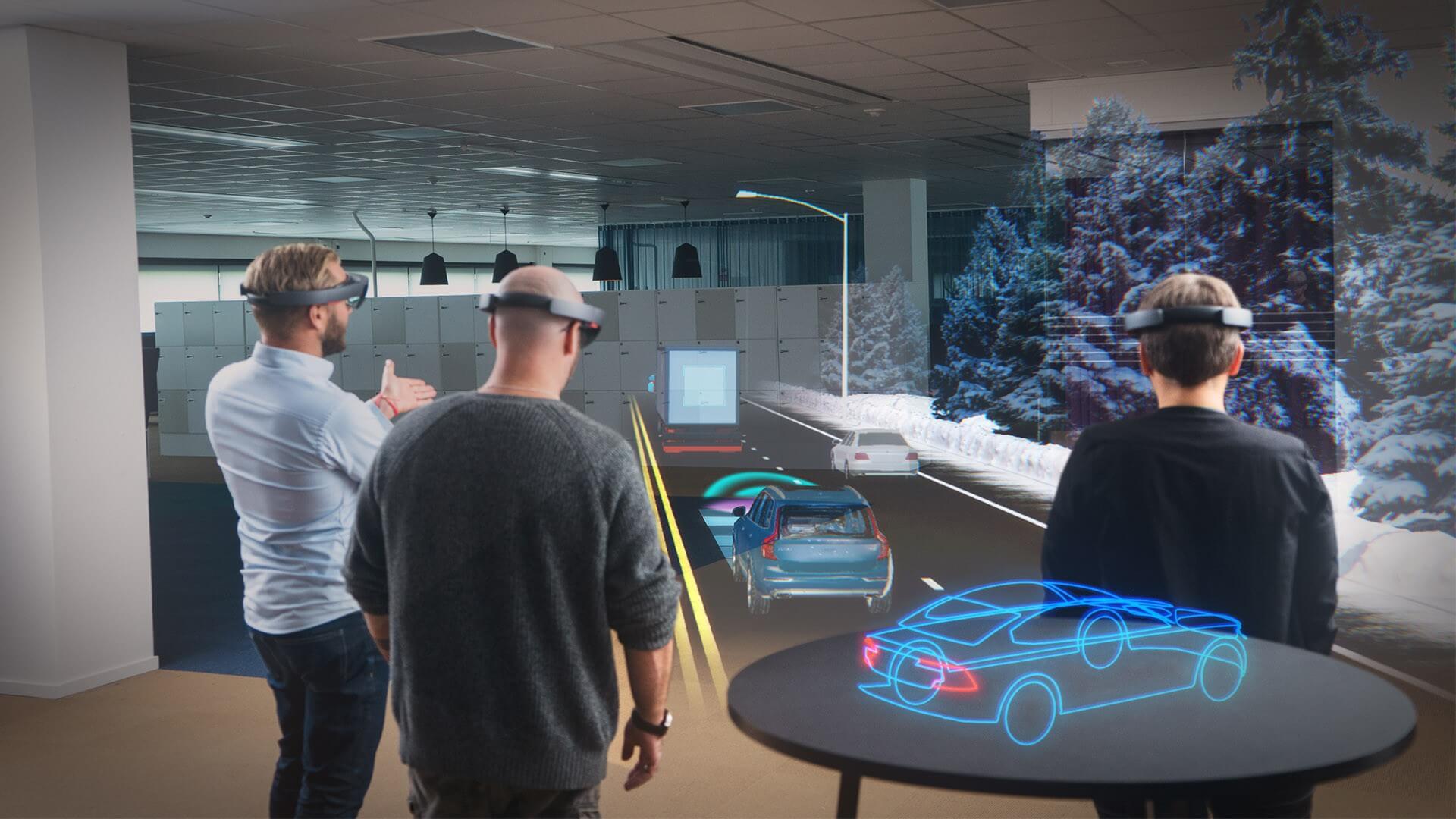After a surprisingly robust 2017, our collective attentions now turn to the new year, and many questions arise as to what will happen in 2018. Some developments will likely be obvious extensions to themes or ideas that started to take hold over the past 12 months, but there are always a few surprises as well. Exactly what those unexpected developments prove to be is virtually impossible to foretell, but here's a reasoned look at some key themes I expect to drive important advances in the tech industry in 2018.
Prediction 1: AI Will Start to Enable Empathetic, Intelligent Computing

Image: Andy Kelly
As powerful and advanced as the tech products we use everyday may be, it's still a stretch to call them "intelligent." Sure, they can perform impressive tasks, but in many ways, they still can't do the simplest of things, particularly in helping us do what we "meant to do" or thought to do, as opposed to exactly what we told them to do.
The problem boils down to a question of interpretation, or the lack thereof. Eventually, we'll all have devices and services that do what it is we're trying to do in the most intelligent, most efficient way possible. The reality of those completely intelligent devices is still a long way off, of course, but in 2018, I think we'll start to see some of the first significant glimpses of what is yet to come, through key enhancements in the various personal assistant platforms (Alexa, Google Assistant, Siri, etc.).
Specifically, I believe practical advancements in artificial intelligence will start to enable a more contextual form of computing with some of our devices, particularly smartphones and smart speakers. Going beyond the simple question and single, discrete response that typically marks these interactions now, we should start to see more human-like responses to our queries and requests. Multi-part conversations, more comprehensive answers, as well as appropriate and even insightful suggestions based on what it is we're doing (or trying to do), will start to give us the sense that our devices are getting smart.
Ironically, part of the way this development will likely occur is by learning more about people and how they think---essentially building a form of digital empathy. By embedding more of the typical reactions that people have to certain questions, or the awareness of what they typically do in certain situations into AI models, we should start to see our digital devices become just a bit more human. In fact, if the technology advances as I expect, we'll be able to stop calling AI "artificial intelligence" and start calling it "actual intelligence."
Prediction 2: For Semiconductors, 2018 Will be the Year of the Accelerator

After decades of domination by CPUs, the world of semiconductors is witnessing a dramatic transformation in which other types of chip architectures are starting to drive a major shift in power, importance and influence. The process started several years back with the rise of GPUs in applications beyond just their traditional role of computer graphics, most notably machine learning and artificial intelligence. Since then, we've seen many other important types of chip architectures come to prominence, from old-line concepts like FPGAs (field-programmable gate arrays) to new ones like dedicated vision processing units (VPUs), AI-focused tensor processing units (TPUs), and much more. Collectively, these alternative chip architectures are often called "accelerators" because they speed up specific tasks.
In 2018, we're likely to see several additional new chip architecture announcements and, more importantly, much wider use of computing accelerators across a variety of devices and applications. From data centers to consumer gadgets, the next year will see a tremendous amount of attention focused on these newer types of more specialized semiconductor chips. To be clear, it's not that CPUs and other traditional computing elements will be going away, but a sizable portion of software development, R&D, and overall focus in 2018 is going to be directed towards these game-changing new components.
Part of the reason accelerators are so important is because they're more specifically targeted tools. While CPUs are still great general-purpose computing engines, these computing accelerators are designed to do certain tasks faster and more efficiently. Realistically, none of the individual accelerators will have the same level of influence that CPUs have had, but collectively, their impact in the new year will be strongly felt.
The implications of the shift away from general purpose semiconductors to more tightly focused chips are huge. Not only will this development drive changes in terms of how products are designed, and what types of products are built, but it will also likely shift the role and influence that designers and builders of these chips have on the overall tech industry supply chain. Plus, though it may not be easy to predict exactly what new technology-based products will surprise us this year, it's not hard to say that there's a very good chance it's going to be powered by one of these new computing accelerators.
Prediction 3: AR/VR Focus Shifts to Part Time Use

As many predicted, 2017 proved to be a very eventful year for augmented and virtual reality. Last year saw the introductions of Apple's ARKit and Google's ARCore smartphone augmented reality platforms, the release of Windows 10 Mixed Reality headsets, the surprising unveiling of Lenovo's Mirage headset as part of their Star Wars Jedi Challenges collaboration with Disney, the announcement of a low-cost headset from Facebook-owned Oculus, and even the debut of Magic Leap's mixed reality headset.
With all these pieces in place, it would seem that AR and VR are primed to have a very strong 2018 and yet, I believe the opposite will be the case. While this year will certainly enjoy its share of additional announcements and developments for AR and VR products, the general level of enthusiasm and excitement around the category has arguably faded---we've entered the trough of disillusionment.
As a result, I believe 2018 will likely be a year of reflection and refocusing for AR and VR, with particular attention being paid to usage models that are different than what many had originally predicted. Part of the problem is that people have had unrealistic expectations about how often and how long people want to engage in AR or VR experiences. Initial hype around the categories suggested that they could provide a new computing paradigm that would essentially replace our existing all-day devices. The reality, however, is far different. Between the obvious challenges of having to hold your AR-enabled smartphone out in front of you to use an AR app, as well as the physical discomfort of wearing large, bulky headsets, most AR and VR product experiences are measured in small numbers of minutes.
Now, there isn't necessarily wrong with that scenario, if that's what you were led to believe was going to be the case, and if you bought a product that was priced and positioned as an occasional use peripheral. At the moment, however, many AR and VR products are as expensive as primary computing products, and many AR and VR apps presume people will use them for significant amounts of time. That's why this year, I expect to see a lot of effort being spent to develop AR and VR products and experiences that better match their realistic part-time usage levels.
Prediction 4: Edge Computing Transforms the Cloud and Subsumes IoT

For the last few years, it seems, everyone and their sister has been waxing rhapsodically about the virtues and opportunities offered by the Internet of Things (IoT). Connecting all kinds of devices together using simple internet protocol (IP) connectivity standards was supposed to enable smart cities, smart homes, smart factories, heck, pretty much smart everything. And yet, here we stand at the dawn of 2018 and---with a few notable exceptions---very few of those things have really come to pass.
In retrospect, it's not really hard to see why. Just connecting things together doesn't necessarily provide any real value, and even tapping into the new data sources enabled by IoT hasn't proven to be as fruitful as many had hoped.
The IoT exercise hasn't all been for naught, however, because it opened many people's eyes to new types of computing models. In particular, the notion of a fully distributed computing environment, where different types of devices with widely varying levels of computing power can be both connected and organized together in a way that allows them to achieve certain tasks is arguably an evolution of the original IoT concept. Instead of focusing on just the connection of "the things," however, this new model focuses on the combined, distributed compute of "the things." What this does is enables different groupings of devices or infrastructure components to work together in more efficient and more effective manner. It's essentially applying the principles of distributed internet connectivity to computing resources, and in the process, transforming how we think about centralized cloud computing models.
One of the key ingredients in this new, evolved version of the cloud is computing components that sit out at the end of the network, closest to where people who are trying to achieve certain tasks are located. These edge computing elements---which can range from consumer endpoints to industrial gateways to network routers---become a critical part of this new computing fabric, in part, because they pull some of the work that used to be done in centralized cloud computing resources and do that work on the edge. In some instances it's to avoid latency, in others it's to take advantage of unique capabilities found within edge devices, but regardless, they shift the balance of computing power away from the cloud at the center of everything and towards a highly distributed, edge-driven model. We saw the beginnings of this trend in 2017, but in 2018 edge computing will start to deliver on the promises originally made by IoT and drive not just a more connected, but a more intelligent tech device world.
Prediction 5: 5G Drives New Types of Competitive Connectivity

With the recent formalization of the 5G NR (new radio) specification (part of 3GPP Release 15 to be exact), the telecom industry has entered into an exciting phase. 2018 will not, however, see the official unveiling nor the commercial availability of 5G---you'll have to wait until at least 2019 for that. The new year will start to bring us some critical connectivity enhancements, though, many of which will be inspired by 5G.
While most people are focused on the expected speed enhancements to be offered by 5G, many of the more exciting ideas associated with the forthcoming broadband wireless network standard have to do with the range of connectivity options becoming available. In particular, the ability to have a consistent connectivity experience, regardless of your location, the number of people/devices around you, and other mitigating factors that commonly limit the speed or quality of our connections, is a key goal for 5G. In addition, there's a growing need for extremely low power connectivity options for some types of devices that live out at the network edge.
Thankfully, many of these same principles and some of the key underlying technologies necessary for 5G will be showing up in other places in 2018, with the net result being that we'll start to enjoy some 5G-like benefits this calendar year.
The latest WiFi standards (802.11ax and 802.11ay), for example, are expected to make a formal appearance in 2018. They will leverage both the kind of spectrum efficiency and signal modulation enhancements that 5G will use to fit more connections/data into a given amount of radio "space," as well as using millimeter wave radio technologies (in the case of 802.11ay) for transmitting data at faster rates (though over shorter distances).
This year should also see the wider appearance of several technologies that combines elements of LTE and WiFi, including LAA (Licensed Assisted Access), LWA (LTE-WLan Aggregation), and MulteFire, all of which offer improvements in wireless service by using some of the unlicensed radio spectrum currently used by WiFi to deliver wireless broadband 4G LTE signals.
In addition, with the proposed purchase of Sigma Designs by Silicon Labs in 2018, we should see the combination of Zigbee and ZWave---two ultra-low-power connectivity options primarily used in smart home applications---in future iterations of the combined company's products.
Ironically, many of these newly enhanced connectivity options arguably inspired at least somewhat by 5G may end up competing with it at some point past 2018, but for the next year, we should be able to enjoy the enhanced connection benefits.
Prediction 6: Tech Business Models Fall Under Increasing Scrutiny

After years of blissful detachment, the tech industry faced an unprecedented amount of pushback and scorn in 2017, as major tech companies like Google, Facebook, Uber and more found themselves in challenging political, judiciary, and legislative environments. In 2018, the pressure that tech companies face will likely increase, and I expect that scrutiny will start to extend to business models as well.
The tech industry continues to perform extraordinarily well from an economic and business outcome perspective, and it's generally been seen as a safe haven for investment. However, it's also been granted extraordinary leeway when it comes to valuations for companies that---were they in any other industry---would be considered to have pretty questionable business models (from a potential profitability perspective, that is).
Tech-focused venture capitalists, hedge fund managers, and other financiers have managed to create and nurture an environment where businesses built on pretty flaky ideas continue to survive and even support one another. At some point, this house of cards is likely to fall and with increasing amounts of unwanted attention being focused on the tech industry, 2018 could be the year that it does.
In particular, I think we'll see questions around "sharing economy"-based companies (such as Uber, etc.), which enjoy enormous valuations despite not having made any profits, and are unsafely dependent on regulations that could easily change. In addition, despite the current hype, cryptocurrencies like Bitcoin---which represent the penultimate example of a technology valuation based on essentially nothing but an interesting idea---are likely to face serious challenges in 2018 as well.
Prediction 7: Voice Computing Cacophony

Image: CNET
As intriguing, popular and powerful as voice-based computing devices like smart speakers are proving to be, I expect that natural language processing (NLP)-driven interactions are going to start facing some serious challenges in 2018. Why, you ask? In part, I think they could end up being a victim of their own success.
Because of the popularity of voice-based personal assistants, we're starting to see the technology embedded across a wide range of devices, from lamps, to TVs, to cars and beyond. In addition, after initial experiments with a single unit, many people have started putting smart speakers all over their homes. The practical net result is that sometime in 2018, a large percentage of personal assistant users will have regular access to multiple assistants simultaneously---often across multiple platforms. Combine that with the fact that in 2018 we'll likely start seeing vendors enabling people to customize the trigger word for these various assistants to start listening and, well, it's a quick recipe for disaster.
Imagine what will happen, for example, if, for consistency's sake, you change them all to respond to "computer" and then you ask a question or make a request to the "computer." Yikes! (Or, at least, an interesting exercise.) As it is, I've started to see a few people talk about how they've heard their Google Assistant automatically respond to their Amazon Echo (or vice versa). Throw in your own queries and the chances for vocal computing mayhem will likely be very high.
Tech vendors can obviously start to plan for a few of these potential outcomes and consumers can try to avoid them, but this isn't the only challenge associated with the realities of multiple competing assistants in a single household. What if you actually want to take advantage of the different assistants to do different tasks because you find one is better at responding to one kind of query than another? In essence, you'll have to try to learn to speak the unique "language" of each assistant and direct the appropriate query to the appropriate assistant. We may see third-party vendors try to create a "meta-assistant" that doles out different questions to different assistants and becomes the single point of interaction, but the likelihood of competing tech vendors enabling this type of capability seems low.
Don't get me wrong, I'm certainly excited about the potential that voice-based interactions can bring to speakers and all our tech devices, but I'm concerned we could hit some serious roadblocks in 2018.
Bob O'Donnell is the founder and chief analyst of TECHnalysis Research, LLC a technology consulting and market research firm. You can follow him on Twitter @bobodtech. This article was originally published on Tech.pinions.
